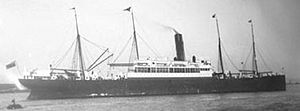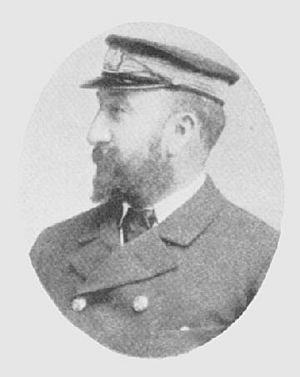SS Mohegan facts for kids
 |
|
Quick facts for kids History |
|
|---|---|
| Name | SS Mohegan |
| Operator |
|
| Builder | Earle's Shipbuilding and Engine Company, Hull |
| Launched | April 1898 |
| Maiden voyage | 31 July 1898 |
| Renamed |
|
| Fate | Wrecked on 14 October 1898 |
| General characteristics | |
| Class and type | Steam merchant ship |
| Tonnage | 3,670 tons |
| Length | 475 feet |
| Beam | 52 feet |
| Propulsion |
|
| Speed | 13 knots |
| Capacity |
|
The SS Mohegan was a large steamship that sadly sank on its second trip. This happened off the coast of the Lizard Peninsula in Cornwall, England. On October 14, 1898, the ship hit a group of rocks called The Manacles. Out of 197 people on board, 106 lost their lives.
Contents
Building the Mohegan
The ship was first named the Cleopatra. It was designed to carry both passengers and animals. The Cleopatra was one of five ships built at Earle's Shipbuilding and Engine Company in Hull. It was made for the Wilson & Furness-Leyland Line.
The ship was built to be very safe. It had eight special walls called bulkheads that could stop water from spreading if there was a leak. It also had reliable lighting and pumping systems. There were eight lifeboats, each able to hold 59 passengers. The ship could carry 120 first-class passengers and had space for 700 cattle.
The Cleopatra never sailed for the Wilson & Furness-Leyland Line. Instead, the Atlantic Transport Line bought it. This company needed new ships because some of their old ones were being used by the U.S. government for the Spanish–American War. The Cleopatra and four other ships (the Alexandria, Boadicea, Victoria, and Winifreda) were bought for about £140,000 each.
First Voyage as Cleopatra
The Cleopatra's first journey was from London to New York. It started on July 31, 1898, and arrived on August 12, 1898. During this trip, some problems quickly appeared. The water system for the boilers didn't work well, and there were several serious leaks. People thought the ship was built too quickly.
The crew worked hard to keep the ship running. Passengers complained to the company about the ship's poor condition. However, they also praised the officers and crew for their excellent work. The Cleopatra returned to London, but it had to go at half-speed. This made the journey take 21 days. Once it docked, the ship had 41 days of major repairs. After that, it was tested and checked by the Board of Trade. The ship was declared safe to sail and was then renamed Mohegan.
The Mohegan's Last Journey
The Mohegan left Tilbury Docks for New York on October 13, 1898, at 2:30 PM. Captain Richard Griffith, who was 42 years old, was in command. The ship carried 57 passengers, 97 crew members, seven cattlemen, and 1,286 tons of goods like spirits, beer, and antimony.
The ship reached Dover at 7:30 PM and dropped off its pilot. A report from the Assistant Engineer was likely sent ashore then. It mentioned a few small leaks and electrical issues, but no major problems.
The Mohegan then sailed at its fastest speed down the English Channel. It stayed close to the coast as it passed Cornwall. However, the ship took a wrong turn. Some officers and crew noticed this. They saw that the Eddystone Lighthouse was too far away and the coast was too close. The ship neared the entrance of Falmouth Harbour. It then turned towards the Helford River entrance and continued down The Lizard coast. It did not slow down from its speed of 13 knots.
The Coverack coastguard noticed this and tried to warn the ship with rockets. The Mohegan either didn't see the signals or ignored them. It kept its course. James Hill, who was in charge of the Porthoustock lifeboat, saw the ship. Its lights were on, and it was heading at full speed towards the Manacle Rocks. He shouted, "She's coming right in!" and called his crew.
Hitting the Manacles
The crew finally realized the danger, either from the shore signals or a bell on a buoy. The engines were stopped at 6:50 PM, but it was too late. The Mohegan crashed onto the Manacles. Its rudder got stuck in the rocks, and the hull (the ship's body) was torn open. The ship first hit Vase Rock and then drifted onto the Maen Varses reef.
Dinner was being served, so many passengers didn't immediately know how serious the accident was. The engine room quickly filled with three feet of water. The steam gauges broke, and the crew rushed to the deck. The ship soon went dark. With no power, passengers went to the deck, where people tried to launch the lifeboats.
Captain Griffith had ordered a second rail to be placed near the lifeboats. This was meant to stop people from rushing them in an emergency. But now, this rail made it harder to launch the boats. More problems came when the ship tilted to the left side (port) and then heavily to the right side (starboard). Only two lifeboats were launched. One was almost full of water, and the other flipped over.
The ship rolled over and sank 12 minutes after hitting the rocks. 106 lives were lost. Captain Griffith, Assistant Engineer William Kinley, and all the officers went down with the ship. Only its funnel (smokestack) and four masts stayed above the water. The Porthoustock lifeboat Charlotte was launched in 30 minutes. It rescued most of the survivors from the wreck and the water. In total, 44 people were saved.
After the Wreck
Most of the bodies found were buried in a large grave at St Keverne churchyard. The Atlantic Transport Line paid for a special stained glass window there to remember them. Some bodies were sent to London for burial. Eight bodies were sent to New York on the Mohegan's sister ship, the Menominee.
The Scottish poet William McGonagall wrote a poem about the tragedy called The Wreck of the Steamer "Mohegan". Most of the cargo from the ship was saved. Sadly, a diver died while trying to salvage items. The wreck slowly broke apart over the years. The third officer, William Logan Hindmarsh, who was 30, is buried in the graveyard in Coverack. His gravestone says the ship company paid for his burial.
The sinking of the Mohegan, and later the stranding of the ocean liner SS Paris, led to the creation of the Coverack lifeboat. The remains of the Mohegan wreck are popular with divers. Sometimes, items like dishes and brass portholes are found. A beautiful staircase saved from the wreck is now in the Coverack youth hostel.
The ship's bell is kept at the Bell Inn in Thetford, Norfolk.
Images for kids
See also
 In Spanish: SS Mohegan para niños
In Spanish: SS Mohegan para niños







